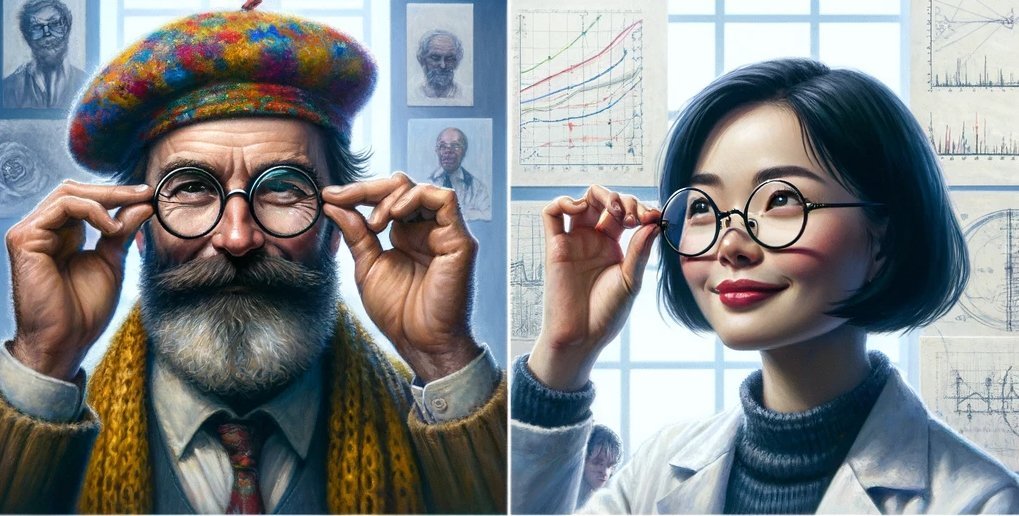The Lenses of Artists and Scientists Explored
This is the first of two blog posts looking at Theory of Knowledge (ToK) Essay #6 Nov 2024: what can be gained if artists adopt the lens of the scientist, and scientists adopt the lens of the artist? The main blogpost for this essay title is linked here.
The video accompanying this blogpost is linked here, and below.
The Pursuit of Knowledge
The term "pursuit of knowledge" is not explicitly defined in the International Baccalaureate ToK Study Guide giving students a degree of freedom in their interpretation of the term. Broadly, the pursuit of knowledge could be thought to encompass both the production and acquisition of knowledge. It suggests an active, intentional effort by knowledge producers (who construct knowledge) and knowers (who collect and learn knowledge). Understanding this term is the first step in exploring the potential benefits ("gains") through the exchange of scientific and artistic lenses.
Understanding the Lens of the Artist and the Lens of the Scientist
Before we tackle the potential gains from the exchange of lenses, it's useful to consider what we may mean by the "lens of the artist" and the "lens of the scientist."
The Lens in the pursuit of knowledge.
The Lens of the Artist
The lens of the artist is informed by values, assumptions, typical methods and tools, conventional theories, and principles that guide the production and acquisition of artistic knowledge.
This lens has many characteristics, including:
Definition of Knowledge: Knowledge can be defined either by the artist or the knower, highlighting a flexible approach to what constitutes knowledge.
Ethical Codes: Artists often adhere to flexible and dynamic ethical codes, allowing for a broad interpretation of what is ethical in the creation and dissemination of artistic knowledge.
The Lens of the Scientist
Conversely, the lens of the scientist is shaped by values, methods, tools, theories, and principles used in the scientific production and acquisition of knowledge.
This lens has many characteristics, including:
Methodology: The scientific lens often utilises a limited range of accepted methods for constructing knowledge, prioritising rigor and repeatability.
Fixed Knowledge: Knowledge is typically external, measurable, and fixed, reducing subjectivity and focusing on quantifiable outcomes.
Potential Gains from Lens Exchange
Scientists Adopting the Lens of Artists
If scientists were to adopt the lens of the artist, they might gain significant flexibility in defining what is considered scientific knowledge. Traditionally, scientific knowledge is defined through rigorous methods like the scientific method and peer review. Adopting an artist's lens could democratise this process, potentially allowing for a broader range of contributors and innovative perspectives. Additionally, embracing the artist's flexible ethical codes could provide scientists with greater freedom to explore and define what is deemed ethical in their research. This could lead to new knowledge that would not have been created using conventional ethical codes.
Artists Adopting the Lens of Scientists
For artists, adopting the scientific lens could lead to a more structured approach to producing artistic knowledge. Whilst this might limit some creative freedoms, it could also introduce a new level of discipline and precision to artistic practices. The concept of making artistic knowledge external, measurable, and fixed could challenge artists to produce works that are less open to interpretation, possibly appealing to new audiences seeking clarity and precision.
Conclusion
This blogpost is only an introduction to the key terms in ToK Essay #6 Nov 2024, the next blogpost demonstrates an approach to answering the whole question. This blogpost describes 4 characteristics of the lenses of artists and scientists. There are many other characteristics that students could consider when writing this essay. The TokToday Essay Guidance Notes for ToK Essay #6 Nov 24 looks at 26 different characteristics of the lenses of artists and scientists. The Essay Guidance notes also contain a wide range of knowledge arguments, real life examples, evaluation points and implication points for this essay. youThey can be picked up from this link.
Watch the accompanying video on YouTube






